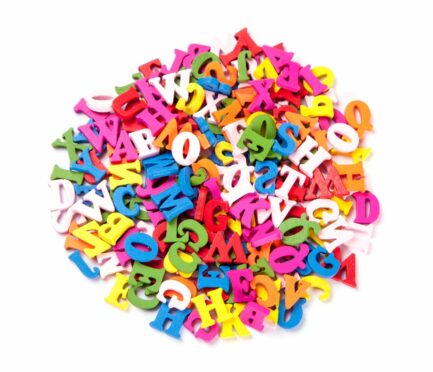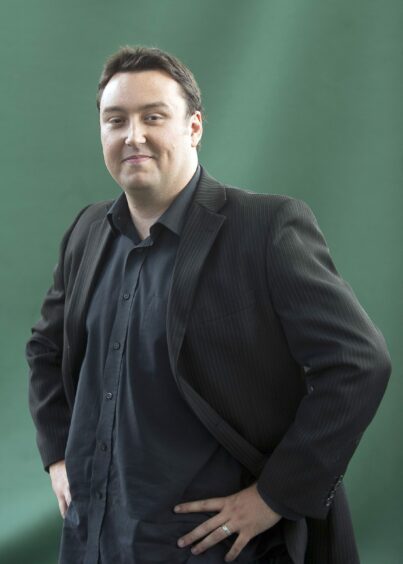
A terrorist group dressed in Santa suits lays siege to an Inverness shopping centre two days before Christmas. What they don’t realise is that one of their trapped shoppers is a disgruntled retired police officer now working as an inside man for his former colleagues to make sure everyone gets home safe for Christmas.
Anyone reading Barry Hutchison’s latest DS Hoon crime thriller, Eastgate, could easily picture its action-fuelled plot playing out on TV. Anyone, that is, except the author.
It’s not that he thinks his plots wouldn’t lend themselves to a small-screen adaptation. Rather, when it comes to creating a mental picture of anything, be it the action in his latest novel or the birth of his children, Hutchison can’t see anything at all.
The author, from Fort William, has aphantasia, a phenomenon also referred to as “mind blind”, so is unable to visualise images in his mind, even of familiar objects or family members. He struggles to remember people he meets and mentally recalls songs in his own voice. Yet he dreams in images.
“It’s an inability to see mental pictures,” explained Hutchison, 44. “It’s not a medical condition, there’s no cure. It’s just how some people’s brain works differently.”
It was during the 2020 lockdown, while chatting with his wife Fiona, daughter Mia and son Kyle, when Hutchison realised that he perceived things in his head differently from his family.
“My daughter was talking about mentally picturing something and I’d always assumed that ‘mental picture’ was just a phrase for thinking about something,” he recalled. “Then I realised what she was explaining was literally a picture that she could see.
“She described the process of seeing something in your mind’s eye and I laughed thinking it was ridiculous until my wife and son asked what I was going on about. It was only then I realised most people can shut their eyes and picture something but I can’t. I see darkness and think exclusively in words.
“If you asked me to think of a beach, I don’t see an image of a beach but instead I’m aware of all the words that describe the concept of a beach. What is interesting is I see things when I dream and that seems to be common with aphantasia. But when I’m awake, if I shut my eyes and try to picture a blue ball, I get nothing. Just darkness.”
While it might seem a strange concept, for a long time Hutchison presumed what he was experiencing was the norm.
He said: “I remember as a kid being confused when my dad told me to count sheep when I couldn’t sleep, or at school the teacher would ask us to visualise holding a number of apples in each hand to help us count. That never made sense to me. To me, go picture that in your head meant, go think about it. I’m not seeing any imagery, just thinking in words. The concept of meditation or picturing yourself somewhere else is like science fiction to me.”
Hutchison can’t call up a visual memory and requires a photo to trigger a recollection: “My memory is terrible because when you remember something you make a mental thumbnail that you tag to a fact to form a memory but I can’t do that. All my childhood memories are based on remembering things from photos but sometimes I think I’m just remembering seeing the photo before.”
When it comes to significant moments like the birth of his children, Hutchison explained: “I remember it happening. I remember the feelings and emotions but I can’t conjure an image of it. Quite often I’ll forget having met someone because their face isn’t familiar enough. There’s one poor author I’ve met three times and every time I do I say, it’s lovely to finally meet you!
“Even with my own books, I need to go back and read the previous couple of books before I write the next one because I can’t remember what happened in them.”
Yet it seems that, for Hutchison at least, visualisation isn’t central to the creative process. In fact, aphantasia has helped him become a prolific writer, able to write an entire book in a matter of weeks.
“A lot of writers will imagine a scene and translate that picture into words,” he said. “For me, it just comes out as words that I immediately write down, so I skip that extra step. It’s weird but because I type so fast, I feel like I’m reading it as my fingers type it out. I’ve always written quickly. I wrote about 180 kids’ books in 10 years and finished Eastgate in about a month. I have a treadmill set up with a desk, so I walk while I’m writing anywhere between 3,000 and 5,000 words a day.”
When Hutchison’s productivity began to hugely outstrip demand from his publishers, he set up his own digital-first publishing company, Zertex Media, in 2016.
He began writing and publishing crime fiction under the pen name JD Kirk three years ago with A Litter Of Bones, the first in his successful DCI Jack Logan series. The latest Logan book, Here Lie The Dead, was published in September, plus there are four novels in his spin-off series with the character DS Hoon, the latest being Eastgate, released this month.
“I set up my own company because I’d quickly write six books in a series but my publisher would only want to release one a year,” said Hutchison. “When I was writing for children, many of my books were under pen names because I was writing so many that I was competing with myself. This way, once I’ve written a book, I can put it out there straight away for people to read.”
Around 2% of people could have aphantasia but it is not yet known what causes it. The term was coined in 2015 by neurologist Dr Adam Zeman of the University of Exeter, who has gone on to lead The Eye’s Mind project which investigates the phenomenon.
Hutchison has now met researchers at Glasgow University who are investigating the condition and will soon undergo a functional magnetic resonance imaging scan to help experts learn more about the connection between aphantasia and brain activity.
He said: “The research isn’t going to make much difference to me as it doesn’t affect me negatively but it will be interesting to find out why people experience this. This is how my brain works, for better or worse.”
Eastgate by JD Kirk is published by Zertex Media

Enjoy the convenience of having The Sunday Post delivered as a digital ePaper straight to your smartphone, tablet or computer.
Subscribe for only £5.49 a month and enjoy all the benefits of the printed paper as a digital replica.
Subscribe © Steve Black/Shutterstock
© Steve Black/Shutterstock